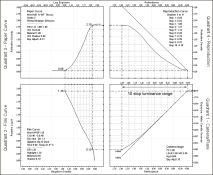Nope, I' claiming no such thing becasue it isn't using any thinking of that kind. By reducing ISO by half you are getting an extra stop of shadow detail at the bottom end and by reducing dev by 30% you are bringing zone 9 into grade 2 territory. Its ball park and not science or related to any sensitometric measurements. QUICK AND DIRTY as I said.
You have two different subject luminance ranges fitting onto a grade 2 paper with a range from black to white. One has a 7 1/2 stop luminance range (BTW, normal is based on 7 1/3 stops). The other has 10 stops. You are implying that by reducing the development time by 30% for the ten stop scene it will result in the same negative density range as the 7 1/3 stop scene processed normal.
Example 1: 7 1/3 stop subject luminance range, Negative Processing time 7 min, CI 0.58 (Normal), Negative Density Range 1.05, Paper LER 1.06, Paper Density Range 1.88

Example 2: 10 stop subject luminance range, Negative Processing time 5 min, CI 0.46 (- 30%), Negative Density Range 1.28, Paper LER 1.06, Paper Density Range 2.12

Example 1: NDR 1.05, PDR 1.88
Example 2: NDR 1.28, PDR 2.12
They are not equal.
BTW, Time/Gradient curves are different for each film/developer combination. Changing the percentage of the processing time can produce very different results. Some form of average gradient is the most accurate way to communicate a target contrast.



 I disagree with some of Ralph's ideas on tone reproduction, and how Davis tends to over-simplify certain concepts in order to fit them nicely into a system. If you want to understand how sensitometry and tone reproduction works with the Zone System, Davis is the way to go. He is pretty solid on theory. Ralph's book has a broader scope and doesn't go into as much detail on those subjects.
I disagree with some of Ralph's ideas on tone reproduction, and how Davis tends to over-simplify certain concepts in order to fit them nicely into a system. If you want to understand how sensitometry and tone reproduction works with the Zone System, Davis is the way to go. He is pretty solid on theory. Ralph's book has a broader scope and doesn't go into as much detail on those subjects.





